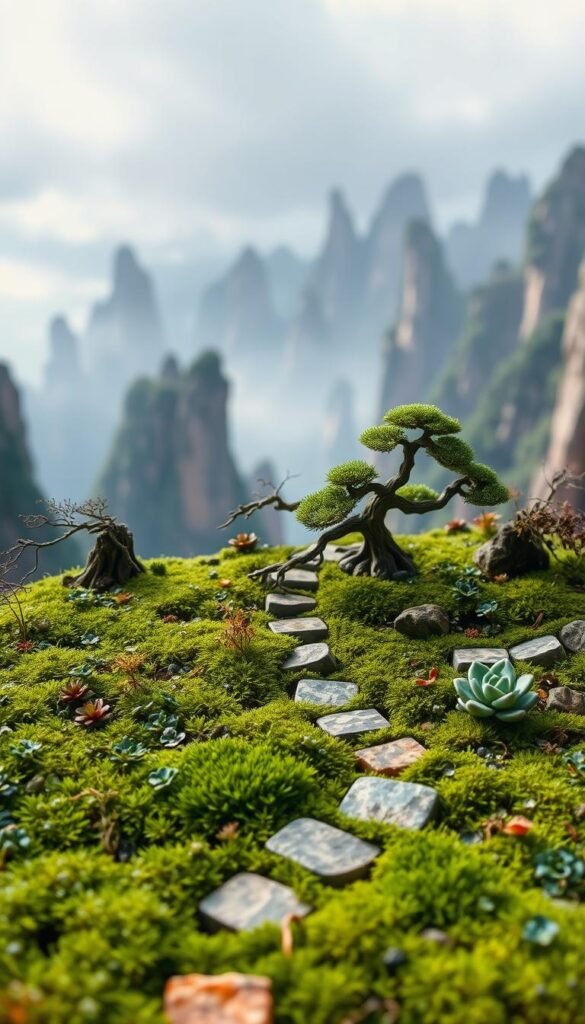Imagine bringing the magic of nature into your home or patio with a creative project that fits even the busiest schedules. Small-scale plant arrangements let you enjoy the rewards of gardening without demanding hours of upkeep. As one professional designer puts it: “There’s something special about building a complete world in miniature—it’s playful, imaginative, and deeply satisfying.”
These projects allow you to include dream elements like bridges, cozy seating areas, or winding pathways—features that might feel overwhelming in larger spaces. Best of all, you can experiment freely with layouts and plant pairings, learning as you go. This hands-on approach makes it a favorite for both seasoned gardeners and newcomers craving a relaxing hobby.
Why has this trend taken root? For starters, it’s affordable, adaptable, and thrives in compact spaces like windowsills or tabletops. You’ll also discover how techniques like layering textures or using scale-appropriate decorations create striking visual depth. Whether you’re crafting a fairy-tale scene or a modern retreat, the possibilities are endless.
By the end of this guide, you’ll know how to build your own captivating small-world ecosystem. From selecting plants to maintaining your creation, we’ll cover everything to help you start confidently. Let’s unlock the joy of turning tiny ideas into thriving, living art.
Introduction to Miniature Garden Design
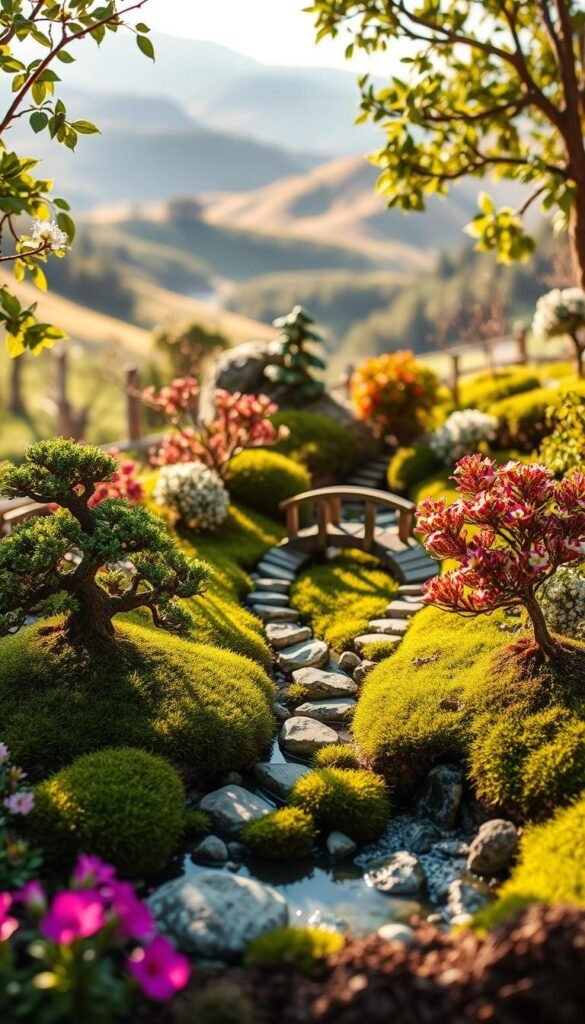
Small-space gardening brings big rewards, blending creativity with nature’s beauty. Think of it as landscaping’s playful cousin—you get to arrange tiny bridges, stone paths, and leafy hideaways that spark joy in unexpected places. “The best part?” asks landscape artist Mara Thompson. “You can create a whole storybook scene for less than the cost of a weekend getaway.”
This hobby thrives because it adapts to any lifestyle. Apartment dwellers use teacups as planters, while suburban homeowners craft elaborate tabletop forests. Nurseries now stock slow-growing succulents and micro-ferns perfect for these projects. You’ll find everything from mini birdhouses to pebble-sized gravel at local stores.
Why try it? First, it’s a low-stakes way to test design ideas. Swap plants or rearrange decor without digging up your yard. Second, these living dioramas teach how different species interact—moss loves shade, while alpine plants crave sunlight. Finally, they become conversation starters that evolve with your skills.
Whether you’re crafting a zen retreat or a fairy village, this blend of art and horticulture invites you to rethink what’s possible. As one enthusiast notes: “It’s not just about plants—it’s about building a little world that makes you smile every time you see it.”
Essential Tools and Materials for Miniature Gardens
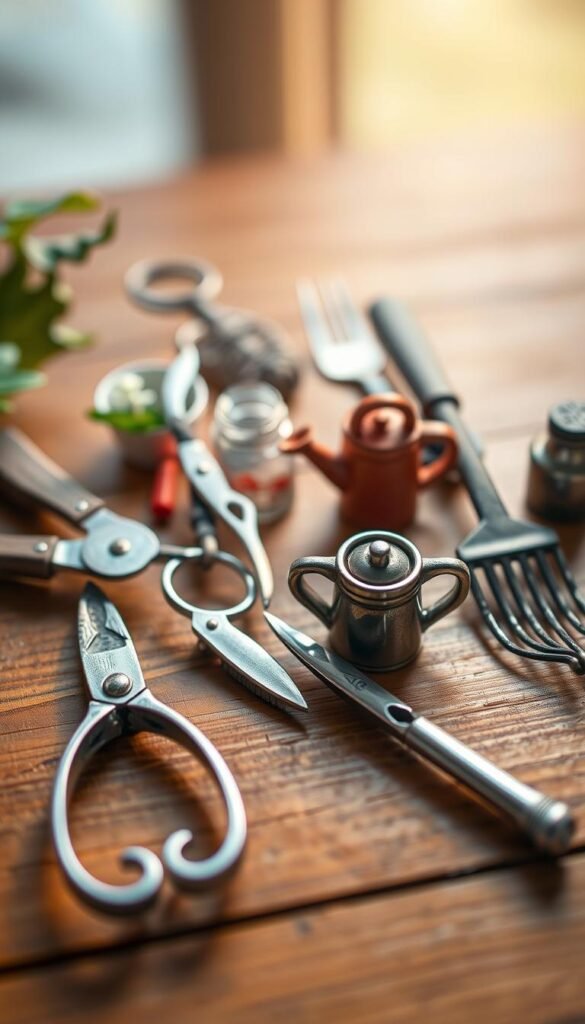
Building your small-scale oasis starts with the right gear. Whether you’re shaping plants or arranging decor, having quality supplies makes the process smoother—and way more fun. Let’s break down what you’ll need to bring your vision to life.
Must-Have Gardening Tools
Precision is key when working in tight spaces. Small trimmers let you prune plants without damaging nearby stems. A mister keeps soil moist without flooding roots—perfect for delicate setups. Add tweezers for placing tiny pebbles and a spoon for scooping soil, and you’ve got a starter kit that fits in a pencil case.
Sourcing Affordable Materials
Start with organic potting soil rich in peat. It holds moisture while letting roots breathe. Moistened sheet moss acts like a living carpet, preventing soil spills. For decor, check craft stores for polished stones or shop aquarium gravel sections—it’s cheaper than specialty garden rocks.
Repurpose household items like bottle caps as mini ponds or broken tiles as pathways. Seasonal sales at dollar stores often yield gems like beach glass or tiny figurines. One parent even turned this into gardening activities for preschoolers, using old toys as playful accents.
With these basics, you’ll spend less time hunting supplies and more creating. As one hobbyist quips: “Half my materials came from junk drawers—my garden’s basically a treasure map!”
Choosing the Perfect Container for Your Mini Garden
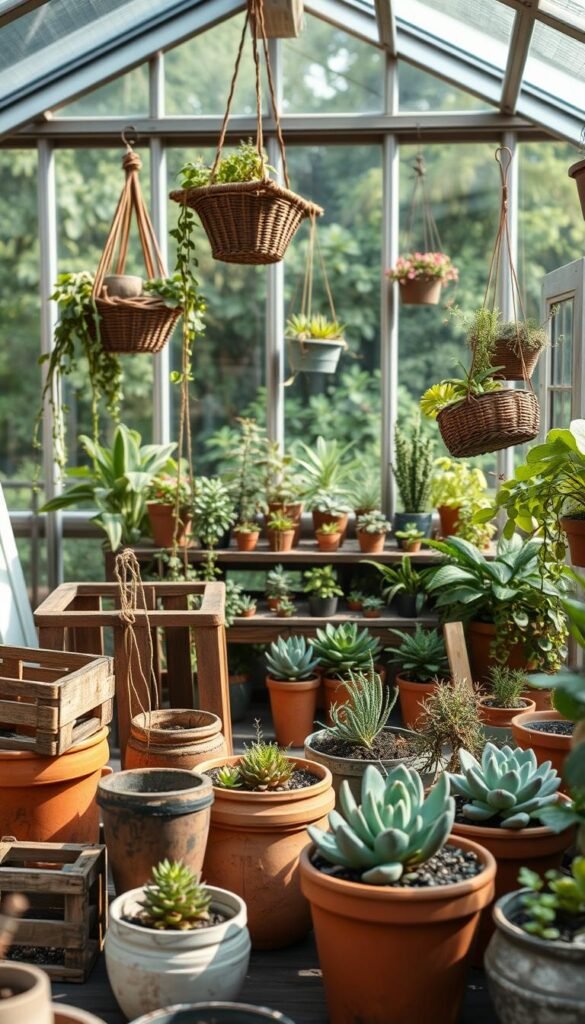
Finding the ideal home for your small-scale plants might surprise you—it’s not just about looks, but function too. Many enthusiasts spend weeks hunting for vessels that balance depth, drainage, and visual charm. “Your container sets the stage,” notes urban gardener Lila Chen. “It’s the frame for your living artwork.”
Beyond Basic Pots: Creative Solutions
Hypertufa planters offer a DIY way to craft rugged, stone-like homes. Mix peat moss, perlite, and cement in a basket mold to create textured walls. For quicker options, try repurposed baking tins or bonsai pots—their shallow depth prevents root overcrowding.
Check unconventional spots for hidden gems. One hobbyist transformed a fabric store’s boat-shaped basket into a whimsical planter. Wooden crates work well for rustic themes, while hammered copper bowls add modern flair.
Size Matters: Practical Considerations
Always prioritize drainage holes—drill them yourself if needed. Aim for containers 2-3 inches deep to control plant growth. Wider vessels (8+ inches) let you create winding paths or layered scenes without cramping elements.
Balance scale by matching container size to your tallest accessory. A 12-inch planter suits 4-inch figurines perfectly. Test layouts before planting: can you reach all areas for maintenance? As Chen advises: “If your tweezers can’t fit, it’s too crowded.”
Understanding Scale: Plants and Accessories
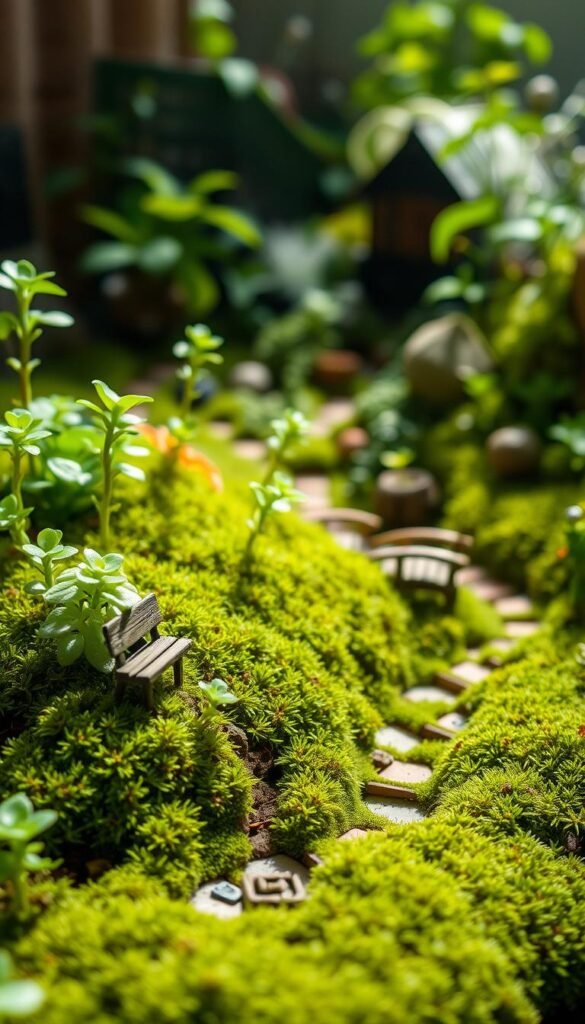
Creating a believable tiny world starts with mastering proportion. Just like dollhouse furniture needs to match its surroundings, your greenery and decorations must work together. “Think of it as nature’s theater set,” says landscaper Elena Rivera. “Every leaf and pebble plays a role in the story.”
Focus on species that stay compact naturally. These superstars thrive in small spaces:
- Texture builders: Mosses, ajugas, and sempervivums add lush groundcover
- Vertical interest: Mini liriope and armeria bring height without bulk
- Spillers: Silver falls or wire vine cascade over edges
Mix leaf shapes and colors for depth—creeping thyme’s purple blooms pop against sedum’s blue-green pads. Rotate sun-lovers like rosemary to brighter spots and shade-preferring moss away from windows. Remember: even slow growers need occasional trims to keep their miniature proportions.
Accessories should enhance, not dominate. A bench taller than your plants breaks the illusion. Stick to 1:12 scale items (1 inch = 1 foot) for harmony. When elevating your space, let nature lead—a single tiny lantern often outshines cluttered decor.
Expect to refresh your arrangement every 6-12 months. It’s not failure—it’s part of the journey. As Rivera notes: “The best gardens grow with their creators, changing just enough to stay magical.”
DIY Miniature Garden Projects from Trusted Sources
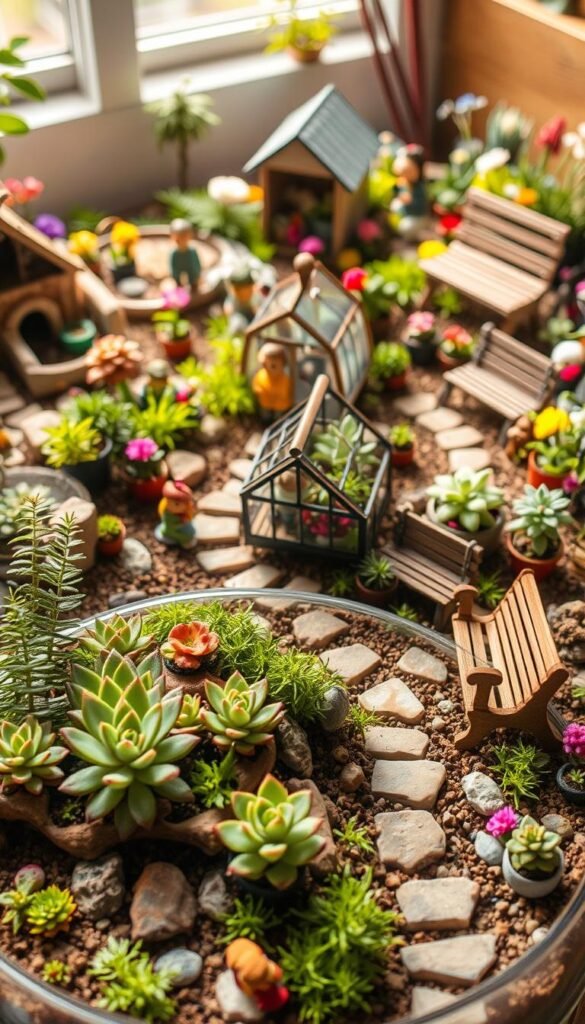
Ready to roll up your sleeves? Let’s dive into hands-on projects that turn everyday items into enchanting small-world escapes. These tutorials from expert creators blend practicality with whimsy—perfect for crafting your first mini garden or leveling up existing skills.
Step-by-Step Setup for a Unique Garden
Start simple with a terracotta pot farm scene. Line the base with gravel for drainage, then add soil mixed with sand for succulents. Place a miniature birdhouse as a focal point, surrounded by creeping thyme. “Layer textures slowly,” advises urban gardener Priya Patel. “Let each element breathe before adding the next.”
Follow these core steps for success:
- Choose a theme (rustic, modern, fairy tale)
- Select 2-3 plants with matching light needs
- Position tallest elements first (houses, trees)
- Fill gaps with moss or decorative stones
Creative Adaptations for Small Spaces
No patio? Try magnetic planters on your fridge. Use air plants glued to tiny magnets, paired with painted clay mushrooms. Apartment dwellers love mason jar gardens—layer pebbles, activated charcoal, and soil for a self-contained ecosystem.
Upcycle wicker baskets into portable landscapes. Line them with plastic sheeting, add herbs like oregano, and top with pebble paths. One renter even crafted a container gardening masterpiece using thrifted teacups on a windowsill.
Pro tip: Use removable putty to secure accessories. This lets you rearrange scenes seasonally without disturbing roots. As Patel notes: “Your first project isn’t permanent—it’s a playground for ideas.”
Seasonal Miniature Gardens: Embracing Holiday Themes
Transform your space with living decor that shifts with the calendar. Holiday-themed arrangements let you celebrate nature’s cycles while flexing your creative muscles. “I raid Christmas ornament aisles for tiny treasures,” laughs hobbyist Jamie Cole. “Those miniature tools and watering cans? Perfect for winter scenes!”
Christmas Magic in Miniature
Create a festive wonderland using dwarf Alberta spruce as your Christmas tree centerpiece. Add battery-operated fairy lights and cotton batting “snow” for instant charm. Scatter tiny presents wrapped in foil or repurpose jewelry charms as ornaments. Cole suggests: “Bottlebrush trees from craft stores add whimsy without breaking the bank.”
Three tips for holiday success:
- Use cinnamon sticks as rustic fences
- Press cranberries into soil for pops of color
- Swap summer plants for cold-hardy sedums
Spring Renewal & Summer Energy
Welcome warmer months with mossy lawns and flowering succulents. Plant spring bulbs like miniature daffodils in clusters for impact. Come June, swap them for drought-tolerant delosperma. Add seashells for coastal themes or painted butterflies for woodland vibes.
These living displays make thoughtful gifts year-round. Package a fall scene with mini pumpkins or a summer setup with tiny beach chairs. As seasons change, rotate decorations to keep your creation fresh. After all, the best part of seasonal gardening? There’s always something new growing.
Miniature Garden Design Ideas: Crafting Tiny, Detailed Landscapes
Transform ordinary containers into breathtaking vistas that captivate the imagination. Professionals layer elements like a painter building texture—starting with tall “trees” at the back, working forward to gravel pathways and mossy clearings. “The magic happens when you make viewers forget the container’s edges,” explains designer Clara Ruiz. This approach turns small spaces into expansive worlds worth exploring.
Building Depth with Layered Elements
Create convincing scenes using this three-zone system:
| Layer | Components | Purpose |
|---|---|---|
| Background | Tall grasses, small shrubs | Establishes height & scale |
| Midground | Miniature benches, stone walls | Adds narrative interest |
| Foreground | Groundcover plants, pebbles | Guides the eye forward |
Use curved pathways to suggest hidden areas beyond the planter’s rim. A zigzagging gravel trail makes spaces feel larger than they are. Pair blue-toned sedums with warm terracotta accents for natural contrast that draws attention.
Water features like mirror shards or resin ponds add reflective surfaces. Position them near your tallest plants to mimic real lakes surrounded by forests. Ruiz suggests: “Tilt accessories slightly—a crooked fence post or leaning ladder makes scenes feel lived-in.”
Finally, tell stories through seasonal changes. Swap summer’s blooming thyme for autumn’s golden moss. Add a tiny rake beside your “tree” when leaves fall. These subtle shifts keep your living art dynamic and engaging.
Terracotta and Natural Materials in Mini Garden Design
Unlock the rustic charm of terracotta to elevate your small-scale landscapes. These earthy pots bring warmth to any setup, blending seamlessly with wood accents or stone pathways. “Terracotta’s natural texture makes every scene feel grounded,” notes container gardening expert Diego Martinez. Their neutral tones let colorful plants shine while adding organic contrast.
Using Terracotta Pots Creatively
Stack pots vertically to craft tiered displays. Place a small saucer between layers as a planting shelf. Cracked pots? Turn them into whimsical “ruins” by partially burying shards—perfect for fairy tale themes. Paint interiors with chalk paint for a weathered look that lasts through seasons.
Pair terracotta with moss-covered branches for woodland vibes. The pots’ porous walls help prevent root rot by absorbing excess moisture. For coastal scenes, glue seashells along rims using waterproof adhesive. One hobbyist transformed a thrifted pot collection into a desert oasis with cacti and miniature clay animals.
Pro tip: Rub damp sphagnum moss on new pots to speed up natural patina development. This creates instant aged character without waiting years. As Martinez advises: “Let materials guide your story—rough textures suggest wilderness, while smooth finishes lean modern.”
Incorporating Polymer Clay and Recycled Elements
Elevate your creations with materials that spark both creativity and sustainability. Polymer clay and repurposed items let you build one-of-a-kind accents while reducing waste. This approach turns everyday objects into storybook-worthy features—think mushroom-shaped cottages or sun-powered fountains.
Crafting Unique Garden Accents
Shape polymer clay over empty cans to create charming cottages or fairy houses. Once baked, these pieces withstand outdoor conditions, making them ideal for long-term displays. Use cookie cutters for uniform shapes or sculpt freehand for organic textures. A hobbyist shares: “I turned old spice jars into clay-covered lanterns—they glow softly at night!”
Eco-Friendly DIY Projects
Transform plastic bottles into solar-powered lights by embedding LED strips inside. Fill clear containers with colored water for stained-glass effects. For pathways, crush eggshells into gravel-like mulch. These budget-friendly solutions reduce landfill contributions while adding whimsy.
Mix materials for dynamic results—pair clay roofs with twig walls or bottle-cap ponds. Let your style shine through custom colors and patterns. After all, the best projects reflect your imagination and care for the planet.

